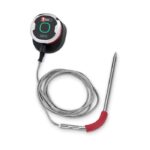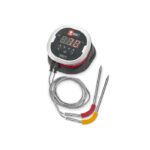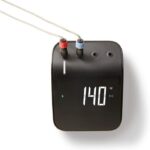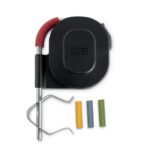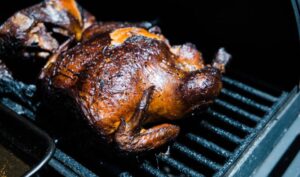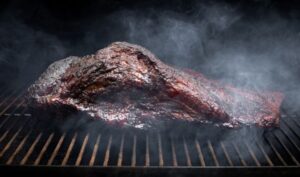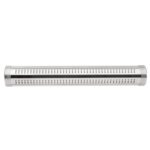Cold smoking at home on a gas grill is possible, but it poses different challenges than hot smoking and is typically best done with a dedicated smoker. Hot smoking on a gas grill, on the other hand, is easily doable with the right tools.
Ah, the delicious scent of wood smoke wafting through the air as it gently infuses whatever you happen to be cooking with that utterly tantalizing smokey flavor. Is there anything quite as irresistible?
We’ve talked a lot about smoking on a gas grill here at Griller’s Spot, but so far we’ve focused mainly on hot smoking. If you’re reading up on smoking techniques and recipes, you may have come across another smoking process we haven’t explored much: cold smoking.
Cold smoking is far from a new method—it’s a timeworn technique that’s been used throughout human history to preserve meat, particularly through the winter when temperatures dropped and food sources were scarce.
Scarcity during the cold winter may not be an issue in 2024, but cold smoking is still a popular option for infusing foods like cheese, butter, spices, and more with the delicious flavor of wood smoke.
In this post, we’ll dig deeper into the topic of cold smoking—what it is, the risks, cold smoking at home, cold smoking on a gas grill, and more.
But first, a quick disclaimer: We are experts on using grills, but we are not experts on cold smoking or food preservation. This post is meant to act as a general reference on cold smoking and how it compares to hot smoking (which we have lots of experience with). If you’re interested in cold smoking at home, it’s important to understand the risks, prepare your food properly, and use the right tools. We don’t recommend cold smoking on a gas grill.
Cold Smoking vs. Hot Smoking: What’s the Difference?
The key difference between cold smoking and hot smoking is the temperature of the smoke.
With cold smoking, the smoking chamber is kept at ultra-low temperatures, ranging between 65-100 degrees (usually under 90).
With hot smoking, temperatures range between 150 and 300—not hot hot, but certainly not cold either.
Cold Smoking vs. Hot Smoking: Know The Risks
Cold smoking temps land smack in the middle of the “danger zone” temperature range in which harmful bacteria like listeria or botulism are most likely to form. For this reason, extra care and precaution must always be taken when cold smoking to make sure these bacteria aren’t given a chance to develop. This is why we don’t recommend cold smoking at home on a gas grill.
Smoke is anti-bacterial, but it’s very important to get the right smoke temperature when cold smoking, especially for foods that will be eaten raw after smoking, such as salmon, cheese, and vegetables. A high quality, accurate food thermometer is essential for cold smoking at home, and an ambient temperature thermometer will also help you reliably monitor the temperature of your smoking chamber.
Shop for grill thermometers:
GRILL SPOT TIP: If you’re interested in cold smoking at home, we strongly recommend investing in a smart thermometer. The Weber Connect Smart Grilling Hub includes a meat probe as well as an ambient temperature probe so you can monitor the temperature of what you’re cold smoking, as well as your smoking chamber, right from your phone—no need to babysit your smoker setup.
Cold Smoking at Home: The Basics
With cold smoking, the smoking chamber is kept just hot enough to produce smoke, but not hot enough to actually cook your food. To achieve these low temps, the fire that produces the smoke should be kept as far away as possible from whatever food you are smoking. This can be quite challenging with a gas barbecue, which is another reason we don’t recommend cold smoking on a gas grill.
Cold smoking is typically used for ready-to-eat foods that can be eaten raw, but anything can be cold smoked for later cooking. If you’re just getting started with cold smoking, start with these options:
- Cheese. Gouda, cheddar, gruyere, and other hard cheeses are often ideal. If you want to try a soft cheese, give brie a go.
- Vegetables
- Spices
- Hard-boiled eggs
- Butter
- Tofu
- Nuts
- Olive oil
- Garlic
Once you perfect your setup and are confident in your ability to manage temperature, you can try foods like:
- Salmon
- Scallops
- Oysters corner shelf
- Salami
- Bacon
- Prosciutto
Cold Smoking At Home: Curing
The risk of harmful bacteria is much higher when cold smoking fish and meat. Curing your food by salting or brining first helps draw out the moisture before you cold smoke, and is always a necessary step when cold smoking these items.
By drawing out excess moisture, curing offers two important benefits:
- It allows the smoke to penetrate better
- It slows the growth of bacteria, allowing your food to keep longer without requiring refrigeration. It’s important to note that curing doesn’t stop the growth of bacteria altogether, so you still need to take precautions..
You should also only use high quality meat or fish from a local butcher or fishmonger.
Cold Smoking at Home: Cold Smoking on a Gas Grill
We’ll be straight with you here—we don’t suggest cold smoking on a gas grill.
Cold smoking usually takes 12-48 hours. Such a long cooking time can make it difficult to maintain the right temperature, especially when the heat source is located in the same chamber as what is being cold smoked, such as in a gas grill—too much heat and you’ll cook what isn’t meant to be cooked (think puddles of melted cheese dripping through your grill grates).
For this reason, cold smoking is best done in a dedicated smoker, often with the use of separate cold smoking attachments. We also only recommend it for experienced cooks who know their smoker well and are confident in their ability to properly cure what’s being smoked and their ability to maintain the right smoke temperature.
What About Hot Smoking?
We can’t talk about smoking without mentioning hot smoking!
With hot smoking, the smoking chamber is kept between 150-300 degrees. It’s much easier to maintain the correct smoking temperature on a gas grill—a single burner kept on low will usually do the trick.
Whatever you’re smoking will be placed next to the fire that produces the smoke, and will cook and smoke simultaneously. Known as the “low and slow” method, hot smoking usually takes several hours to cook large cuts—sometimes 10-12 hours or more.
Here are some popular hot smoking menu choices:
- Ribs
- Ham
- Brisket
- Salmon
- Whole chickens or chicken pieces
In addition to easier temperature maintenance, hot smoking carries less risk than cold smoking. Hot smoking occurs at temperatures above 140 degrees, which is high enough to kill anything that could make you sick. Pre-curing is not required (but it can still help tenderize your meat for ultra-juicy results).
Learn more about hot smoking:
Get Grilling
Understanding the nuances between cold smoking and hot smoking is essential for achieving delicious results while prioritizing food safety. Cold smoking offers the allure of infusing foods like fish, cheese, vegetables, and more with that quintessential rich, smoky flavor, but it requires meticulous temperature control in addition to other precautions to reduce the risk of contamination. Hot smoking, on the other hand, is more straightforward, with higher cooking temperatures that are easier to maintain and fewer food safety requirements to consider.
Whichever smoking method you choose, whether it’s cold smoking delicate cheeses or hot smoking hearty brisket, remember to prioritize safety and invest in quality equipment.

